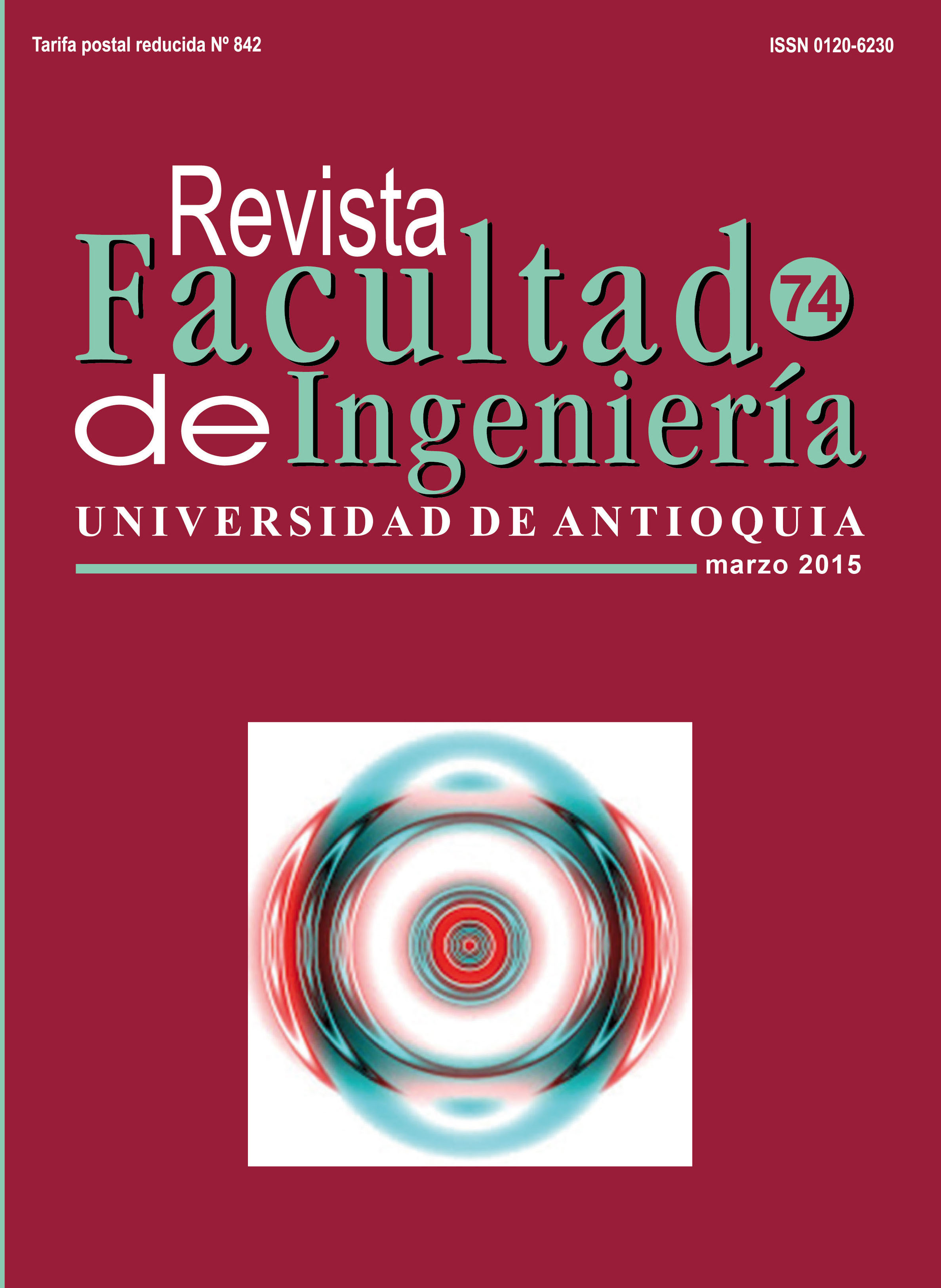Design methodology applied to Photovoltaic System with Inductor Tapped Topology
DOI:
https://doi.org/10.17533/udea.redin.15463Keywords:
inverter converter with tapped, MIC, photovoltaic systemAbstract
In order to transform DC in AC ready to be delivered to the electrical-grid, the concept of AC Module is typically applied; however, the use of this scheme, presented are some quality problems in the generation of energy, as, voltage gain low, high THD and low conversion efficiency. As a solution, a tapped-inductor topology is proposed to design an inverter into a Module Integrated Converter (MIC). The proposed converter and its control system are evaluated by simulations. The simulation results were verified using an 80 watts prototype, which is the maximum power rating for a single photovoltaic module, in the obtained experimental results can be appreciated that the prototype working in a real photovoltaic system: increases the voltage gain, increases the efficiency and reduces the harmonic distortion with respect to a traditional converter.
Downloads
References
B. Bose. “Global warming: Energy, environmental pollution, and the impact of power electronics”. IEEE Ind. Electron. Mag. Vol. 4. 2010. pp. 6-17. DOI: https://doi.org/10.1109/MIE.2010.935860
H. Oldenkamp, I. Jong. AC modules: past, present and future. Workshop installing the solar solution. Hatfield, UK. 1998. pp. 1-6.
B. Verhoeven. Utility Aspects of Grid Connected Photovoltaic Power Systems. Report IEA-PVPS T5- 01, KEMA. Arnhem, Netherlands. 1998. pp. 4-19.
F. Blaabjerg, F. Iov, R. Teodorescu. Power Electronics in Renewable Energy Systems. Proceedings of the 12th International Power Electronics and Motion Control Conference. Portorož, Slovenia. 2006. pp. 1-17. DOI: https://doi.org/10.1109/EPEPEMC.2006.4778368
M. Byung, L. Long, K. Jong, K. Tae, Y. Dong, R. Kang, K. Jeong, S. Eui. “A Novel Grid-Connected PV PCS with New High Efficiency Converter”. Journal of Power Electronics. Vol. 8. 2008. pp. 309-316.
C. Woo, C. Jae. “High-Efficiency Power Conditioning System for Grid-Connected Photovoltaic Modules”. Journal of Power Electronics. Vol. 11. 2011. pp. 561- 567. DOI: https://doi.org/10.6113/JPE.2011.11.4.561
CONERGY. Photovoltaic module C125PI Technical Data No. C125PI-TD-MEX-0602. Available on: http://www.solarshop-europe.net/solar-components/solarmodules/conergy_c-125-pi_m_131.html. Accessed: November 16, 2014.
S. Kjaer, J. Pedersen, F. Blaabjerg. “Power inverter topologies for photovoltaic modules-a review”. Proceedings of the 37th IAS Annual Meeting, Conference Record of the Industry Applications. Pittsburgh, USA. 2002. pp. 782-788.
R. Caceres, I. Barbi. “A boost DC-AC converter: analysis, design, and experimentation”. IEEE Transactions on Power Electronics. Vol. 14. 1999. pp. 134-141. DOI: https://doi.org/10.1109/63.737601
H. Kusakawa, H. Nagayoshi, K. Kamisako, K. Kurahaura. “Further improvement of a transformerless voltage-boosting inverter for ac modules”. Solar Energy Material and Solar Cells. Vol. 67. 2001. pp. 379-387. DOI: https://doi.org/10.1016/S0927-0248(00)00306-8
S. Jain, V. Agarwal. “A Single-Stage Grid Connected Inverter Topology for Solar PV Systems with Maximum Power Point Tracking”. IEEE Transactions on Power Electronics. Vol. 22. 2007. pp. 1928-1940. DOI: https://doi.org/10.1109/TPEL.2007.904202
T. Esram, P. Chapman. “Comparison of Photovoltaic Array Maximum Power Point Tracking Techniques”. IEEE Transaction on Energy Conversion. Vol. 22. 2007. pp. 439-449. DOI: https://doi.org/10.1109/TEC.2006.874230
E. Mineiro, S. Daher, F. Antunes, C. Cruz. Photovoltaic System for Supply Public illumination in Electrical Energy Demand Peak. Proceedings of the 19th Annual IEEE Applied Power Electronics Conference and Exposition. Texas, USA. 2004. pp. 1501-1506.
T. Liang, K. Tseng. “Analysis of integrated boostflyback step-up converter”. IEE Proceedings Electric Power Applications. Vol. 152. 2005. pp. 217-225. DOI: https://doi.org/10.1049/ip-epa:20045003
S. Malo, R. Grino. Output Voltage Regulation of a High-Efficiency High Step-Up DC-DC Power Converter. Proceedings of the IEEE International Symposium Industrial Electronics (ISIE). Vigo, Spain. 2007. pp. 854-859. DOI: https://doi.org/10.1109/ISIE.2007.4374709
B. Ju, R. Myung, K. Tae, Y. Dong, K. Jong. High boost converter using voltage multiplier. Proceedings of the 31st Annual Conference on Industrial Electronics Society (IECON). Raleigh, USA. 2005. pp. 567-572.
K. Cheng. Tapped inductor for switched-mode power converters. Proceedings of the 2nd International Conference on Power Electronics Systems and Applications (ICPESA ‘06). Hong Kong, China. 2006. pp. 14-20. DOI: https://doi.org/10.1109/PESA.2006.343060
D. Grant, Y. Darroman, J. Suter. “Synthesis of Tapped-Inductor Switched-Mode Converters”. IEEE Transactions on Power Electronics. Vol. 22. 2007. pp. 1964-1969. DOI: https://doi.org/10.1109/TPEL.2007.904215
J. Fohringer, F. Himmelstoss. Analysis of a boost converter with tapped inductor and reduced voltage stress across the buffer capacitor. Proceedings of the IEEE International Conference Industrial Technology (ICIT). Mumbai, India. 2006. pp. 126-131. DOI: https://doi.org/10.1109/ICIT.2006.372297
S. Araujo, P. Zacharias, B. Sahan. Novel GridConnected Non-Isolated Converters for Photovoltaic Systems with Grounded Generator. Proceedings of the 39th IEEE Annual Power Electronics Specialists Conference (PESC). Rhodes, Greece. 2008. pp. 58-65. DOI: https://doi.org/10.1109/PESC.2008.4591897
B. Yang, W. Li, Y. Zhao, X. He. “Design and Analysis of a Grid-Connected Photovoltaic Power System”. IEEE Transactions on Power Electronic. Vol. 25. 2010. pp. 992-1000. DOI: https://doi.org/10.1109/TPEL.2009.2036432
L. Lin, Y. Hong. Advance DC/DC converters-power electronic and applications series. 1st ed. Ed. CRC Press. Boca Raton, USA. 2003. pp. 59-60
IEEE. Recommended practice for utility interface of photovoltaic systems. Available on: http://ieeexplore.ieee.org/xpl/mostRecentIssue.jsp?punumber=6743 Accessed: November 16, 2014.
Downloads
Published
How to Cite
Issue
Section
License
Copyright (c) 2015 Revista Facultad de Ingeniería Universidad de Antioquia

This work is licensed under a Creative Commons Attribution-NonCommercial-ShareAlike 4.0 International License.
Revista Facultad de Ingeniería, Universidad de Antioquia is licensed under the Creative Commons Attribution BY-NC-SA 4.0 license. https://creativecommons.org/licenses/by-nc-sa/4.0/deed.en
You are free to:
Share — copy and redistribute the material in any medium or format
Adapt — remix, transform, and build upon the material
Under the following terms:
Attribution — You must give appropriate credit, provide a link to the license, and indicate if changes were made. You may do so in any reasonable manner, but not in any way that suggests the licensor endorses you or your use.
NonCommercial — You may not use the material for commercial purposes.
ShareAlike — If you remix, transform, or build upon the material, you must distribute your contributions under the same license as the original.
The material published in the journal can be distributed, copied and exhibited by third parties if the respective credits are given to the journal. No commercial benefit can be obtained and derivative works must be under the same license terms as the original work.










 Twitter
Twitter